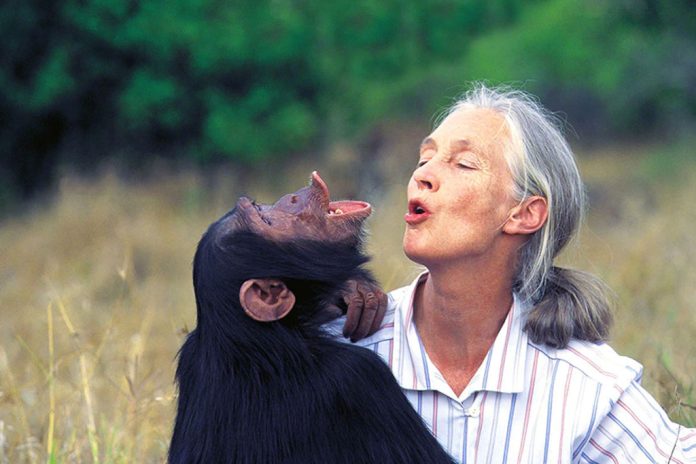Born April 3, 1934, Jane Goodall was raised in a close knit family and was greatly influenced by her Mother Vanne and her Grandmother Danny. Goodall had a sister Judy who was four years younger than herself. They share the same birthday. The sisters were taught prayers at home and could go to the Christian church when they chose to go. Her family instilled values such as courage, honesty, compassion and a tolerance for other people. There were also two aunts Olwen and Audrey Gwyneth who resided with the Goodalls. They had been made homeless by the war. A frequent visitor was their uncle Eric who was a surgeon from London.
Goodall’s father was Mortimer Goodall and was in the military stationed in the jungles of Singapore. He gave Jane a gift when she was about one year old that she still treasures today. It is a toy chimpanzee named Jubilee after a chimp that was famous at the London Zoo at that time. Her parents divorced when she was a child and she and her Mother continued living with Grandmother in the little seaside town of Bournemouth, England.
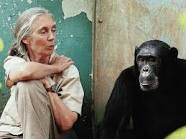
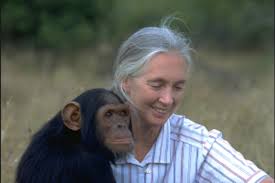
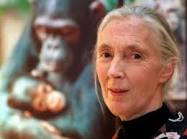
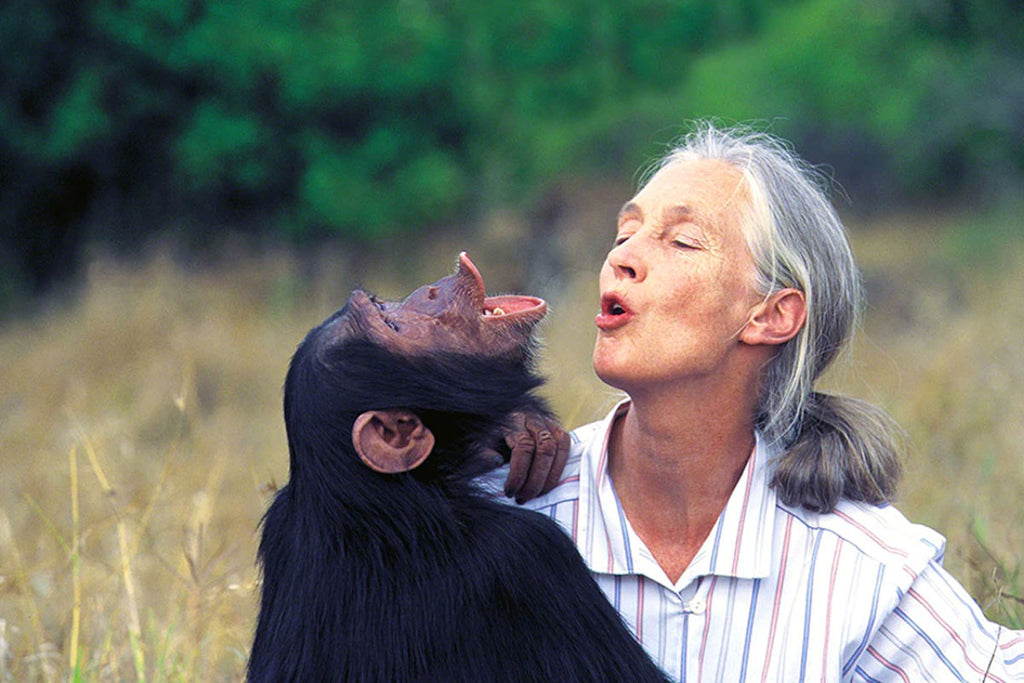
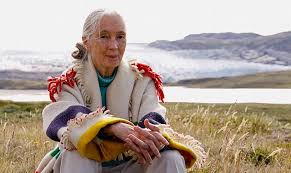
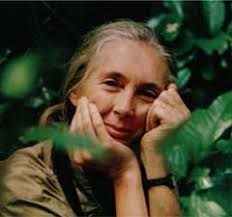
Along with the family members there lived a large number of pets of all types. One of Goodall’s favorites was a dog named Rusty. From an early age she loved to play with and take care of the animals. She enjoyed many friends but was equally happy alone on the seashore where they lived or spending time with her many pets. She was especially fond of climbing trees and sitting up there to read books. These traits would later be useful in helping her enjoy the solitude that would be a major part of her life’s work. She recalls daydreaming of being an adult and traveling and working with animals. That dream did eventually come true for her.
Even in their quiet little town, Jane and her family could see the planes and hear the bombs of the war and watch American tanks on the road near their home. Then, at age eleven, she saw photographs of the German Holocaust that made a lasting, lifelong impression on her.
At age nineteen she moved to London to be a secretary because her Mother suggested that secretarial skills were needed anywhere in the world and this would enable her to travel. After working awhile there, she returned to the town of Bournemouth to work as a waitress while saving money for her first trip. By age 23 she had saved enough to go by ship to visit a girlfriend who had moved to Kenya. Jane’s lifelong ambition was beginning to happen.
The long voyage was filled with fun. In addition she realized the great Power that inspired her. She had grown up with the belief that there is Power in each person and in all the wonders of the world. This journey on the open sea made that Power all the more real to her. When the ship arrived in the harbor of Cape Town in Africa she was struck by apartheid and was suddenly reminded of the horrible scenes of the war in Germany and of the Nazis.
She made an appointment to see Louis Leaky and was hired to be his secretary at the National Museum. Again, a dream come true for her. She was asked to accompany Leaky and his wife Mary on one of their numerous treks to the Serengeti plain. At that time there were no tourists there and it was a very isolate and remote area. They did monotonous, tedious work digging for ancient fossils. Leakey and Goodall, unlike many other scientists, felt that there was a connection between science and religion and that the two studies must be compatible.
After observing how serious and methodical she was, Leaky selected her to do a study of chimps and he obtained the necessary funding for the project. In 1960 it was not considered proper for her to go without a chaperone into the wilds. Her Mother, to whom she was very close, went with her to Tanlganyika which would later be called Tanzania. They stayed there four months in a tent made of poles and a roof of straw. Buffalo would run through the jungle, they heard leopards calling at night, saw deadly cobras and both Jane and Vanne became deathly ill with malaria and had no medications to comfort them. Luckily, they both recovered.
Goodall recalls not having any fear. She attributes this in part to Leaky. He told her that if she were calm and meant no harm to the animals, they would sense that and not harm her. She climbed up a mountain to its peak, looked down and saw two beautiful valleys and a lake. She sat there day and after day waiting for chimps to see her and gradually become used to her presence among them. She would become so calm and the solitude reminded of her of a Theosophy class that she had taken in London. It taught her how to still her thoughts and meditate, and this occurred quite naturally for her while sitting in the jungle.
The first chimp that came close to her was a male with white hair on his face. She named him David Greybeard. She would later watch as he fashioned tools such as using blade of grass to pick up termites to eat much as humans would use a spoon. He would also use leaves to get rainwater. She patiently waited and watch them and they watched her in return. She noticed that they used nonverbal behaviors to show their emotions, i.e. patting each other on the back, holding hands and even holding grudges if they were offended.
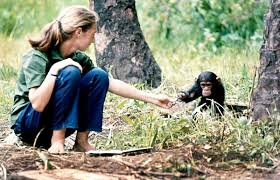

There were difficulties to overcome but Goodall was committed to her work. She had poor self confidence since she did not have any solid credentials as a scientist. She obtained a PhD in ethnology from Cambridge in 1965 at Leaky’s urging and would later teach at Stanford University.
Goodall and her sister have a neurological condition known as prosopagnosia which is a memory impairment for face and patterns. She cannot recognize people’s faces. Interestingly, though, she has no difficulty in deciphering the faces of the chimps that she has tracked and recalling their names.
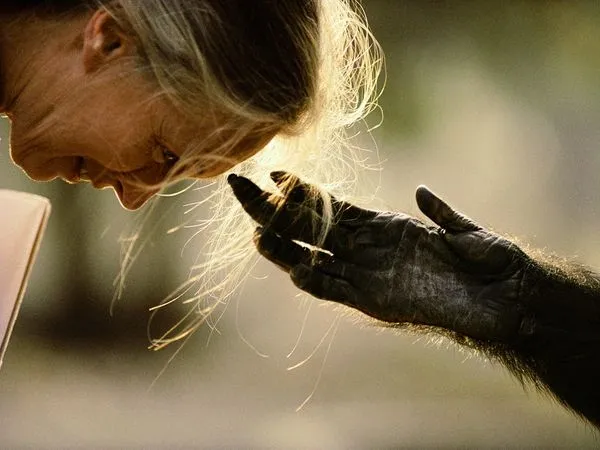
Jane Goodall With Chimp
Photograph by Michael Nichols
Primatologist Jane Goodall bends forward as Jou Jou, a chimpanzee, reaches out to her in Brazzaville, Congo. Goodall revolutionized primatology with her 1960s studies at Tanzania’s Gombe Stream Game Reserve, where she observed chimpanzees making and using tools, a landmark discovery in wildlife studies.
On March 28,1964 she married a photographer for the National Geographic named Hugo van Lawick and, in 1967, they had one son named Hugo Eric Louis but, always, called “Grub”. Grub spent his early childhood on the Serengeti. To spend more time with Grub she stopped following the chimps and had students assigned to that work.
She supervised the research. Much of her style of parenting came from observing the affectionate and tolerant style of mothering used naturally by the chimps. After a few years, she and Lawick divorced and she felt many emotional included loss, failure and guilt. Having a philosophical mind, the divorce and its emotional pain made her question the meaning of life, and then strengthened her belief in a Spiritual Power.
She became internationally prominent in 1965 when National Geographic did a television documentary about her research. She occasionally left Africa to go on lecture tours and was struck by the Western world’s overpopulation. She was saddened by the devastating effects of things like Agent Orange, pesticides and radiation. She was concerned that the western world was spiritually poor. It was more difficult for her to find peace and sense the
great Power when she was away from nature.
Goodall notes that there are similarities but also differences between human beings and chimps. Humans have a complex language that can be used to teach the young about the past and that the past is something that humans need to learned from. Humans have a higher intellect than chimps and can ask what is life’s purpose? Chimps can be aggressive and territorial. Chimps attack each other but, Goodall feels that for humans to wage wars is worse than the wars among chimps. This she bases on the fact that humans have a brain than can ask higher levels of questions. Chimps are only directed by their instinct. They can be taught sign language but do not understand past or future meanings. Humans evolved physically from an ape-man and culturally continued to evolve. There needs to always be a moral development make humans more compassionate and less aggressive. She says that what humans evolved from is not nearly as critical as the direction that the world is going. There is an interdependence between man and everything in nature and that must be respected. Her early work and documentation led other researchers to confirm that chimps have rank and that the higher one’s ranking, the better the food is for that animal. This, in turn, causes better survival rates for high ranking animal’s offspring.
Her interest gradually shifted from making observations of chimps in the jungle to using that knowledge to help the world. She established “Wildlife Awareness Weeks” around the world to boost local economies and aid conservation by providing jobs. She formed a group called “Roots and Shoots” to teach children around the world to respect all living things. She lectures constantly about conservation.
She is a staunch supporter of animal rights and wants better treatment of animals in laboratories and eventually hopes that other methods of research can be utilized. She is a vegetarian and encourages others to follow that path. Not only does meat eating destroy animals but, she explains, it means clearing forests to feed the animals which increases the amount of desert space.
Goodall thinks that people are moving in a good direction toward increased caring for other people and for animals. The main difference between cruelty among animals and among humans is that we have the mental ability to know better. She suggests that having a group of family and friends that support us is okay. However, when we draw dividing lines that separate us from those who are different than ourselves, we are endangering the spiritual growth of humanity.
She endured devastating personal losses. Her work caused her to risk plane crashes, malaria, hardships, rivers full of crocodiles, and the kidnapping of several of her students. Through it all, Jane Goodall is a survivor. These difficult time strengthened her faith in a Greater Power. Through all her adversities, she reminded herself of a quote from the Bible that her Grandmother instilled in her. She would remind herself that “as thy days, so shall thy strength be”.



